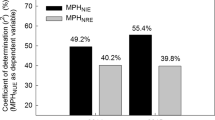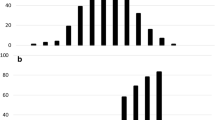Abstract
Increase in maize grain yield in West Africa can be achieved by developing maize varieties tolerant to low soil nitrogen (N) and improving soil fertility. Six maize populations were evaluated in two locations in Nigeria under low-N (45 kg N ha−1) and high-N (90 kg N ha−1) conditions to identify morphological and physiological traits that changed in genotypes that had undergone recurrent selection for tolerance to low soil N and to determine the relationship between physiological and yield traits in both nitrogen environments. Results revealed that improved cycles of three populations displayed longer leaf area duration, larger leaf area ratio, larger leaf area index and higher crop growth rate (CGR) at silking than their earlier versions at 45 and 90 kg N ha−1. Net assimilation rate increased significantly in response to selection in three out of six populations at 45 kg N ha−1. Significant yield changes were observed in response to selection in three populations at 45 kg N ha−1 and four populations at 90 kg N ha−1, accompanied by increments in 100 kernel weight in three populations and number of kernels per row in one population. Grain yield and 100 kernel weight reduced by 31 and 5% respectively in response to N-stress. Among physiological traits, only CGR and SPAD chlorophyll readings had significant positive relationship with grain yield under low and high N conditions. Hence, CGR and SPAD chlorophyll values can be utilized in selecting for tolerance to low-N in maize for West Africa region.
Similar content being viewed by others
References
Abe A, Menkir A, Moose SP, Adetimirin VO, Olaniyan AB (2013) Genetic variation for nitrogen-use efficiency among selected tropical maize hybrids differing in grain yield potential. J Crop Improv 27(1):31–52
Adebo FA, Olaoye G (2010) Growth indices and grain yield attributes in six maize cultivars representing two era of maize breeding in Nigeria. J Agric Sci 2:218–228
Ajala SO, Kling JG, Schulthess F, Cardwell K, Odiyi A (2001) Progress in breeding for resistance to maize stem borers Sesamia calamistis and Eldana saccharina in West and Central Africa. In: Proceeding of the 7th Eastern and Southern African regional maize conference, pp 41–45
Ajala SO, Kling JG, Kim SK, Obamiji AO (2003) Improvement of maize population for resistance to downy mildew. Plant Breed 122:328–333
Ajala SO, Kling JG, Menkir A (2012) Full-Sib family selection in maize populations for tolerance to low soil nitrogen. J Crop Improv 26:581–598
Aliu S, Fetahu SH, Rozman L (2010) Variation of physiological traits and yield components of some maize hybrids in agroecological conditions of Kosovo. Acta Agric Slov 95(1):35–41
Andrade FH, Vega C, Uhart S, Cirilo A, Cantarero M, Valentinuz O (1999) Kernel number determination in maize. Crop Sci 39:453–459
Beadle CL (1987) Plant growth analysis. In: Coombs J, Hall DO, Long SP, Sucrlock JMO (eds) Techniques in bioproductivity and photosynthesis, 2nd edn. Pregamon Press, Oxford, pp 21–23
Bertin P, Gallais A (2000) Genetic variation for nitrogen use efficiency in a set of recombinant maize inbred lines. I. Agrophysiological results. Maydica 45:53–66
Bolaños J, Edmeades GO (1993) Eight cycles of selection to drought tolerance in lowland tropical maize I. Responses in grain yield, biomass and radiation utilization. Field Crops Res 31:233–252
Borras L, Otegui ME (2001) Maize kernel weight response to post flowering source-sink ratio. Crop Sci 41:1816–1822
Bullock DG, Anderson DS (1998) Evaluation of the Minolta SPAD-502 chlorophyll meter for nitrogen management in corn. J crop Nutr 21:741–755
Chapman SC, Barreto HJ (1997) Using a chlorophyll meter to estimate specific leaf nitrogen of tropical maize during vegetative growth. Agron J 89:557–562
Duvick DN (2005) The contribution of breeding to yield advances in maize (Zea mays L.). Adv Agron 86:83–145
Fakorede MAB, Mock JJ (1978) Changes in morphological and physiological traits associated with recurrent selection for grain yield in maize. Euphytica 27:397–409
Fakorede MAB, Mock JJ (1980) Growth analysis of maize variety hybrids obtained from two recurrent programmes for grain yield. New Phytopathol 85(3):393–408
FAO/UNESCO (1974) Soil map of the World. Available at fao.org and accessed in April 2014
Hanway JJ (1971) How a com plant develops. Iowa State University Cooperative Extension Service Special Report, no. 48 (review)
Hirel B, Bertin P, Quilleré I, Bourdoncle W, Attagnant C, Dellay C, Gouy A, Cadiou S, Retailliau C, Falque M, Gallais A (2001) Towards a better understanding of the genetic and physiological basis for nitrogen use efficiency in maize. Plant Physiol 125:1258–1270
Inman D, Khosla R, Reich RM, Westfall DG (2007) Active remote sensing and grain yield in irrigated maize. Precis Agric 8:241–252
Kante M, Revilla P, De La Fuente M, Caicedo M, Ordás B (2016) Stay-green QTLs in temperate elite maize. Euphytica 207(2):463–473. doi:10.1007/s10681-015-1575-0
Kim SK, Efron Y, Khardr F, Fajemisin J, Lee MH (1987) Registration of 16-maize streak virus resistant tropical maize parental inbred lines. Crop Sci 27:824–825
Kumar SN, Singh CP (2001) Growth analysis of maize during long and short duration crop seasons: influence of nitrogen source and dose. Ind J Agric Res 35(1):13–18
Lafitte HR, Edmeades GO (1994) Improvement for tolerance to low soil nitrogen in tropical maize. II. Grain yield, biomass production, and N accumulation. Field Crops Res 39:15–25
Lee EA, Tollenaar M (2007) Physiological basis of successful breeding strategies for maize grain yield. Crop Sci 47:202–215
Menkir A, Kling JG (1999) Effect of reciprocal recurrent selection on grain yield and other traits in two early-maturing maize populations. Maydica 44:159–165
Menkir A, Kling JG (2007) Response to recurrent selection for resistance to Striga hermonthica (Del.) Benth in a tropical maize population. Crop Sci 47:674–684
Muchow RC (1988) Effect of nitrogen supply on the comparative productivity of maize and sorghum in a semi-arid tropical environment. I. Leaf growth and leaf nitrogen. Field Crops Res 18:1–16
Mulumba NN, Mock JJ (1978) Improvement of yield potential of the Eto Blanco Maize (Zea mays L.) population by breeding for plant traits. Egypt J Genet Cytol 7:40–51
NACGRAB (2014) Catalogue of crop varieties released and registered in Nigeria 4(6): 22–34. National Centre for Genetic Resources and Biotechnology (NACGRAB), Ibadan, Nigeria
Purcino AAC, Silva MRE, Andrade SRM, Belele CL, Parentoni SN, Santos MX (2000) Grain filling in maize: the effect of nitrogen nutrition on the activities of nitrogen assimilating enzymes in the pedicel placento chalaza region. Maydica 45:95–103
Racjan I, Tollenaar M (1999) Source: sink ratio and leaf senescence in maize: 1. Dry matter accumulation and partitioning during grain filling. Field Crops Res 60:245–253
Teal RK, Girma BK, Freeman KW, Arnall DB (2006) In-season prediction of corn grain yield potential using normalized difference vegetation index. Agron J 98:1488–1494
Vetsch JA, Randall GW (2004) Corn production as affected by nitrogen application timing and tillage. Agron J 96:502–509
Wolfe DW, Henderson DW, Hsiao TC, Alvino A (1988) Interactive water and nitrogen effects on senescence of maize.1. Leaf-area duration, nitrogen distribution, and yield. Agron J 80:859–864
Acknowledgements
This research was supported by SARD-SC. Maize Project funded by AfDB at the International Institute of Tropical Agriculture, IITA, Ibadan, Nigeria. The authors highly appreciate the excellent technical assistance provided by the staff of Maize Improvement Programme (MIP), IITA, Ibadan.
Author information
Authors and Affiliations
Corresponding author
Rights and permissions
About this article
Cite this article
Udo, E.F., Ajala, S.O. & Olaniyan, A.B. Physiological and morphological changes associated with recurrent selection for low nitrogen tolerance in maize. Euphytica 213, 140 (2017). https://doi.org/10.1007/s10681-017-1928-y
Received:
Accepted:
Published:
DOI: https://doi.org/10.1007/s10681-017-1928-y




